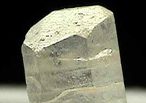Jeremejevite Info
Back to Jeremejevite
Jeremejevite is one of the rarest gemstones. First colorless crystals were found in a pegmatite on Mt. Soktuy (Adun-Chilon Range / Chitinskaya Oblast / Nerchinsk district / Transbaikal / Russia) and described in 1883 by the French mineralogist Augustin Alexis Damour who named it in honor of Pavel Vladimirovich Jeremejev (1830-1899), a Russian mineralogist, crystallographer and engineer.
 |
| Mile 72, etched * |
Other gemmy crystals were found in 2001 in the Erongo Mountains, also in Namibia. Their size usually ranges from microcrystals to approximately 2 cm but a few crystals can be 5 cm long and 1 cm wide, alledgedly up to 8-10 cm.
In 2000, Micro crystals were discovered in in the Eifel Mts. in Germany and alledgedly in the Kukurt massif in the Pamir Mts. in Tajikistan.
* Photo by kind permission of © www.trinityminerals.com, John Veevaert (0.9 x 0,4 x 0,4 cm, Mile 72 / Swakopmund / Namibia).
The Discovery at Mile 72
 |
| 0.49 ct, Mile 72 * |
Some jeremejevite crystals were picked up in 1973 by Mrs. Tannie Klippie, wife of the road-grader operator John Marais. She usually walked behind his grader which turned over the soil, picking up nice minerals from time to time. One day, when John's grader was busy on the road to the Mile 72 fishing camp, she found some pretty crystals and was the first one who discovered jeremejevite again, after its discovery in 1883 in Russia.
Later the "aquamarine" crystals were inspected by experts and finally identified as jeremejevite by the GIA in the same year.
* Photo by kind permission of © Jan-Henrik Meyer.
Color and Quality
 |
| lavender Color * |
Some colorless or light blue crystals are deeper colored on the lower end, attached to the matrix. Like most gemstones the value depends on the clarity and color: the most valuable jeremejevites should be eye-clean and intense cornflower blue, and large. Jeremejevite is usually faceted in a baguette or emerald cut.
* Photo by kind permission of © www.irocks.com, Dr. Robert Lavinsky (1.4 x 1.2 x 1.2 cm, Arandis / Swakopmund / Namibia).
 |
| Crystal on Matrix * |
Apart from micromounts jeremejevite crystals vary from "needles" (up to 2 cm long and 1 mm thick) to
~6 cm long and ~5 mm thick ones. Many crystals elongate toward the upper end. Acceptable crystals still remaining on their matrix are rare. The reason is still unknown. Gebhard and Brunner suggested in 2001 that the pockets may have been damaged by an explosive decompression phase within the pegmatite (source: http://findarticles.com/).
* Photo by kind permission of © http://erongo.50megs.com, Jaco Smith.
⇐ Intro Page ⇐ Gemstones ⇐ Jeremejevite